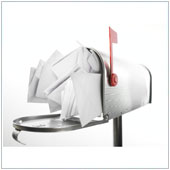
There are too many different kinds of spam messages to count, but here’s nine of the most popular (in no particular order) and how to identify that they are indeed spam:
- Emergency messages – These come from family, or people on your contact list, usually asking you for money because they are stranded or in some other sort of dilemma. While you may have relatives traveling, it’s a good idea to reach out to them using other means of communication when you get an email like this. Be wary, especially if they don’t want to give a phone number or exact location.
- Requests to update your account – These usually come in after a website has had a security breach. They almost always ask you to update contact information, and usually provide a link. Clicking this link will take you to a site that looks almost exactly the same as the real one, only this one usually has viruses or other malicious intent. If you get an email like this, inspect the email and the sender’s email address very carefully – they usually have spelling mistakes – and don’t click any links. Instead, close and log out of your email, go to the website mentioned in the email and log in to see if any updates are actually required.
- Requests for your password – Sometimes spammers don’t even bother to set up elaborate websites, they’ll just grab the company logo, make a fancy letterhead and send you a message asking you for your password. This type of spam usually comes from scammers posing as representatives of a bank or credit card company. Never, ever reply to anyone and provide your password. Legitimate organizations do not ask for user passwords over email.
- Obvious misspellings – Unless you work with people or companies with employees who aren’t native English speakers, obvious misspellings in messages e.g., ‘Here iS som3 FREE Stuffz’, usually indicate the message is spam. If you’re not sure, and you know the sender, contact them yourself. If you don’t know the sender, or the sender has an email address like: pradaoutletonlinestore4u.comGliemATgmail.com, it’s spam.
- Pleas for help – This is a tough one, we all want to help people, but when we receive pleas to help the poor starving hipsters of Manhattan, you have to be skeptical. Charities don’t email you unless you put your name on a mailing list, or gave them your email when you last donated.
- Contest winner – The main rule here is: If you didn’t enter the contest, you’re not a winner, no matter how sweet the prize. The same goes for those spam pop-ups on some websites. You’re not the 1,000,000th viewer, and clicking on the link or shooting the three ducks won’t get you a free iPad. You will get more spam however, or a virus if you’re a really good shot.
- Chain emails – These have been circling the globe more or less since the beginning of the Internet and have now made their way onto Facebook and other social networks. The vast majority of them are harmless, but they are annoying. Think about it, you get one telling you to forward to 10 people or a cute, fluffy kitten will be shaved. If you forward it to 10 people, you’re now the spammer. If you get emails like these, they are spam, just delete them.
- Messages in attachments – Be extra cautious with this one. If you get an email from any contact that says something along the line of, “Please see my message in this attachment,” or has nothing at all in the body, it’s pretty much guaranteed to be spam. That attachment is likely some malicious software. No organizations or companies will send you messages in an attachment, so when you get one, just delete it.
- Awesome deals – Contacted out of the blue by someone offering you an all inclusive ski trip to Steamboat Springs Colorado for just a dollar? Or how about an LV Handbag for just $10? These deals seem too good to be true, and what’s the rule with things that seem too good to be true? They are. Just because it’s in an email or chat message doesn’t mean it’s real. If you get these, don’t click on any links or even reply to the sender, just delete and ignore.
The one common thing with nearly all forms of spam is that the messages usually contain links. If you’re unsure about the link, hover your mouse over it for a few seconds without clicking, and your browser should tell you where the link will take you. That is, your browser will display the address at the bottom of the window. If the link looks unfamiliar, or seems wrong, don’t click it.
An important thing to be aware of is that Spam is unwanted, or unasked-for. If you sign up for a daily newsletter, that’s not spam, you agreed to allow the company to send you messages. Luckily, most of these have links at the bottom of the message you can press to unsubscribe. To learn more about spam, and how to stop it, please contact Providence.

